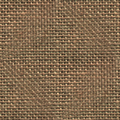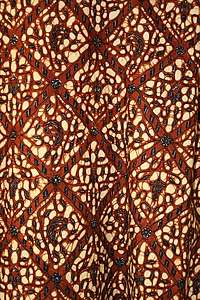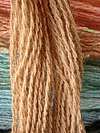Adire (textile art)
Adire (Yoruba: tie and dye) textile is the indigo-dyed cloth made in southwestern Nigeria by Yoruba women, using a variety of resist-dyeing techniques.[1][2]
History
The earliest pieces of this type were probably simple tied designs on cotton cloth handspun and woven locally (rather like those still produced in Mali), but in the early decades of the 20th century new access to large quantities of imported shirting material via the spread of European textile merchants in Abeokuta and other Yoruba towns caused a boom in these women's entrepreneurial and artistic efforts, making adire a major local craft in Abeokuta and Ibadan, attracting buyers from all over West Africa. Abeokuta is considered to be the capital of adire making in Nigeria, however some suggest that the large cities of Ibadan and Osogbo (Yorubaland) are more important in Adire making because Adire dyeing began in Abeokuta when Egba women from Ibadan returned with this knowledge.[3] The cloth's basic shape became that of two pieces of shirting material stitched together to create a women's wrapper cloth. New techniques of resist dyeing developed.
The tradition of indigo dyeing goes back centuries in West Africa. The earliest known example is a cap from the Dogon kingdom in Mali dating to the 11th century, dyed in the oniko style.[4]
However, by the end of the 1930s the spread of synthetic indigo and caustic soda and an influx of new less skilled entrants caused quality problems and a still-present collapse in demand. Though the more complex and beautiful starch resist designs continued to be produced until the early 1970s, and despite a revival prompted largely by the interest of US Peace Corps workers in the 1960s, never regained their earlier popularity. In the present day, simplified stenciled designs and some better quality oniko and alabere designs are still produced, but local taste favours "kampala" (multi-coloured wax resist cloth, sometimes also known as adire by a few people). However, there has been a recent revival of the Adire art by Nigerian artisans such as Nike Davies-Okundaye,[5] who has inspired a younger generation of designers including Amaka Osakwe (and her label Maki-Oh) and Duro Olowu. Political figures and celebrities such as Michelle Obama and Lupita Nyong'o have worn adire-inspired clothes recently.
Techniques
.jpg)
Today, there are three primary resist techniques used in Nigeria:
- Onikan: this process involves tying raffia around hundreds of individual corn kernels or pebbles to produce small white circles on a blue background. The fabric can also be twisted and tied on itself or folded into stripes.
- Alabere: Stitching raffia onto the fabric in a pattern prior to dyeing. The raffia palm is stripped, and the spine sewn into the fabric. After dyeing the raffia is usually ripped out, although some choose to leave it in and let wear and tear on the garment slowly reveal the design.
- Eleko: Resist dyeing with cassava paste painted onto the fabric. Traditionally done with different size chicken feathers, calabash carved into different designs are also used, in a manner similar to block printing. Since the early twentieth century, metal stencils cut from the sheets of tin that lined tea chests have also been used.[4][6]
Most of the designs are named, with popular ones including the jubilee pattern, (first produced for the silver jubilee of George V and Queen Mary in 1935), Olokun ("goddess of the sea"),[7] Sunbebe ("lifting up of the beads")[8] and Ibadandun ("Ibadan is sweet").[9]
Nigeria is also known for its two-tone indigo resist designs, created by repeat dyeing of cloth painted with cassava root paste to create a deep blue; the paste is then washed out and the cloth dyed a final time. Quality cloth is dyed 25 or more times to create a deep blue-black color before the paste is washed out. Additional forms of indigo resist-dyeing exist in other parts of West Africa; for example, the Bamana of Mali use mud resist, while Senegalese dyers use rice paste rather than cassava root, and the Ndop of Cameroon use both stitch resist and wax resist.[4]
References
- Norma Wolff. "Adire". Fashion History:Love to know. Retrieved 25 December 2014.
- "Adire – Indigo Resist Dyed Cloth From Yorubaland, Nigeria". Vam. United Kingdom. 2013-07-24. Retrieved 25 December 2014.
- Simmonds, Doig (2016). Adire cloth in Nigeria. Ibadan: Doig D, Simmonds; Institute of African Studies, University of Ibadan. p. 11.
- Triplett, Kay and Lori Lee (2015). Indigo Quilts. Concord, CA: C&T Publishing. pp. 14–18. ISBN 978-1-61745-243-7.
- Pool, Hannah Azieb (2016). Fashion Cities Africa. Pool, Hannah, 1974-, Royal Pavilion, Art Gallery, and Museums. Bristol, UK. pp. 98–99. ISBN 9781783206117. OCLC 946010715.
- Triplett, Lori Lee (14 October 2015). "Adire: African Resist". C&T Publishing. C&T Publishing. Retrieved 1 April 2016.
- Simmonds, Doig; Oyelola, Pat; Ọkẹ, Ṣẹgun, eds. (2016). Adirẹ cloth in Nigeria, 1971-2016 (Second ed.). [Place of publication not identified]: Doig D. Simmonds. pp. 6–7. ISBN 9780993532405. OCLC 960700743.
- Simmonds, Doig (2016). Adire cloth in Nigeria. Nigeria: University of Ibadan. p. 49. ISBN 978-0-9935324-0-5.
- Simmonds; Oyelola; Ọkẹ (eds.). Adirẹ cloth in Nigeria, 1971-2016 (Second ed.). pp. 47–48. OCLC 960700743.


.svg.png)
